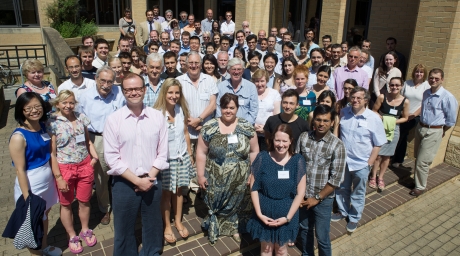
In 1984, the Medical Research Council (MRC) established the Anatomical Neuropharmacology Unit (ANU) attached to the Department of Pharmacology at the University of Oxford under the Honorary Directorship of Professor A. David Smith, with Dr Peter Somogyi as Associate Director. The Unit started operation in 1985 and, in 1998, Professor Somogyi became Director. Professor J. Paul Bolam became the Unit’s Associate Director in 2009. Total membership of the ANU was about fifty to sixty at any one time.
The Unit was established in 1985 with the following terms of reference:
- To study chemical transmitters and synaptic connections of identified neurones in the vertebrate central nervous system.
- To analyse neuronal networks in relation to the functioning of the central nervous system in health and disease.
Staff, students, associated members, and visitors at the MRC ANU pursued multidisciplinary systems neuroscience, tackling cellular mechanisms of network operations in behaviourally- and clinically-important brain systems. The collective vision at the Unit was that explanations of normal and pathological events in the brain can only come from the rigorous spatiotemporal definition of the neuronal circuits that underlie these events. Pursuit of this vision led to seminal discoveries of novel cell types, rules of neuronal interactions, their molecular constituents and temporal dynamics. Each of the ANU’s groups represented the frontiers of its research field. As an MRC-funded Unit, members of the ANU also engaged the public with brain research, as well as biological science in general.
In its final quinquennium of operation, the ANU hosted 7 scientific Programmes funded by the MRC:
Programme 1 (Group Leader: Professor Peter Somogyi FRS FMedSci)
“Co-operative interactions of identified neurons in hippocampal network activity”
Programme 2 (Group Leader: Professor Thomas Klausberger)
“Spike timing in identified neuronal circuits of the medial prefrontal cortex”
Programme 3 (Group Leader: Professor Jozsef Csicsvari [2009-2011], Dr David Dupret [from July 2011])
“Synchronisation of cell assemblies in hippocampo-entorhinal circuits”
Programme 4 (Group Leader: Professor Marco Capogna)
“Contribution of GABAergic neurotransmission to the circuits of amygdala and hippocampus in health and disease”
Programme 5 (Group Leader: Dr R.A. Jeff McIllhinney)
“Functional and molecular characterization of novel GABAB receptor interacting proteins”
Programme 6 (Group Leader: Professor J. Paul Bolam FMedSci)
“Organisation of the neuronal networks of the basal ganglia”
Programme 7 (Group Leader: Professor Peter J. Magill)
“Interactions within and between the basal ganglia and thalamocortical circuits in function and dysfunction”
These ANU Programmes and their predecessors greatly contributed to filling the ‘knowledge gap’ in the cellular mechanisms that underlie the network operations of the central nervous system. The ANU thus generated high-resolution molecular, structural and electrophysiological readouts of brain function and dysfunction in mammals, with a focus on explaining how specific cell types contribute to normal and impaired behaviours. The results spanned multiple functional levels from neurotransmission and plasticity at identified synapses, to the firing of single identified cells in vivo and up to the behaviour-dependent organisation of cell assemblies and macrocircuit dynamics, encompassing all relevant time scales. In this way, the ANU defined the mechanisms that underpin distinct temporal activity, which Professor Somogyi termed the ‘chronocircuit’. Interacting brain regions of major significance for common neurological and psychiatric disorders were studied, including the basal ganglia (Bolam, Magill), neocortex and hippocampus (Capogna, Csicsvari, Dupret, Klausberger, Lamsa, McIlhinney, Somogyi), and amygdala (Capogna, Magill). The ANU greatly benefited from the inputs of its honorary members, including Dr Karri Lamsa, Professor A. David Smith FMedSci and Professor Ray Guillery FRS.
The successes of the MRC ANU are now built upon at the MRC Brain Network Dynamics Unit at the University of Oxford.